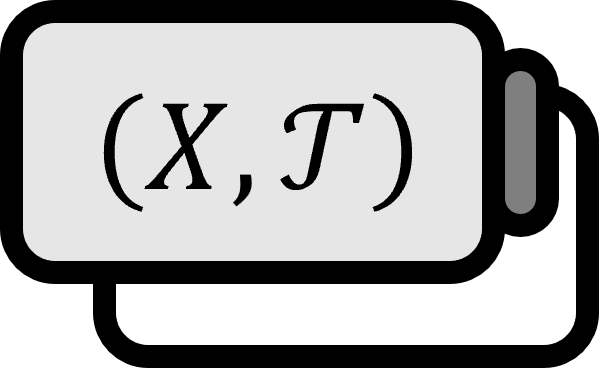Proof of the Alexander Subbase Theorem
Theorem
Let $X$ be a topological space.
$X$ is compact. There exists some subbasis $\mathscr{S}$ for $X$, made up of members of $\iff$ $\mathscr{S}$, such that every open cover of $X$ composed of $X$ has a finite subcover.
Explanation
The importance of compactness goes without saying.
This theorem was originally something Alexander’s teacher wanted to prove about bases. However, he couldn’t prove it for bases and it was Alexander who completed it for subbases.
Honestly, the proof is too long and complex to memorize, but it’s quite ingenious and worth trying out at least once.
Proof
$( \implies )$
$\mathscr{S}$ is a subset of the topology of $X$, so it is trivial.
$( \impliedby )$
Part 1.
Assume that $X$ is not compact.
Let $\mathscr{C}$ be a collection of open covers of $X$ that do not have a finite subcover, since we are assuming $X$ is not compact, therefore $\mathscr{C} \ne \emptyset$. From all the open covers $C \in \mathscr{C}$, let’s construct a new set $\displaystyle \mathscr{O} : = \bigcup C$ by selecting only those that do not have a superset other than themselves. The existence of such a set $\mathscr{O}$ is justified by the Axiom of Choice.
- For example, if $\left\{ \left\{ 1 \right\} , \left\{ 2 \right\} , \left\{ 3 \right\} , \left\{ 1, 3 \right\} \right\}$, then this is like collecting the ‘partially largest sets’ as in $\left\{ \left\{ 2 \right\}, \left\{ 1, 3 \right\} \right\}$.
Part 2. If there exists a $O_{0} \in \mathscr{O}$ satisfying $\displaystyle \bigcap_{i=1}^{n} U_{i} \subset O_{0}$ for an open set $U_{1} , \cdots , U_{n} \subset X$, then there must exist a $i_{0}$ satisfying $U_{i_{0}} \subset \mathscr{O}$.
Consider an open set $U_{1}$ and $U_{2}$ that satisfy $U_{1} \cap U_{2} \subset O_{0}$ for some $O_{0}$. Here, $$ U_{1} \notin \mathscr{O} \\ U_{2} \notin \mathscr{O} $$ is assumed.
Since $\mathscr{O}$ is defined as collecting the partially largest open covers from $\mathscr{C}$, $$ \mathscr{O} \cup \left\{ U_{1} \right\} \notin \mathscr{C} \\ \mathscr{O} \cup \left\{ U_{2} \right\} \notin \mathscr{C} $$ must be true. That means $\mathscr{O} \cup \left\{ U_{1} \right\}$ and $\mathscr{O} \cup \left\{ U_{2} \right\}$ have finite subcovers that cover $X$, which are $$ \left\{ O_{1} , \cdots , O_{m} , U_{1} \right\} \subset \mathscr{O} \cup \left\{ U_{1} \right\} \\ \left\{ O_{1}’ , \cdots , O_{l}’ , U_{2} \right\} \subset \mathscr{O} \cup \left\{ U_{2} \right\} $$ and thus, $$ \begin{align*} X \subset& X \cap X \\ \subset& \left( \left( \bigcup_{i=1}^{m} O_{i} \right) \cup U_{1} \right) \cap \left( \left( \bigcup_{i=1}^{l} O_{i} ' \right) \cup U_{2} \right) \\ \subset& \left[ \left( \bigcup_{i=1}^{m} O_{i} \right) \cap \left( \bigcup_{i=1}^{l} O_{i} ' \right) \right] \cup \left( U_{1} \cap U_{2} \right) \end{align*} $$ But since it was stated $U_{1} \cap U_{2} \subset O_{0}$, $\left\{ O_{1} , \cdots , O_{m} , O_{1}’ , \cdots , O_{l} , O_{0} \right\} \in \mathscr{O}$ is a finite subcover of $X$. This contradicts the definition of $\mathscr{O}$, hence our assumption $$ U_{1} \notin \mathscr{O} \\ U_{2} \notin \mathscr{O} $$ is wrong. Therefore, either $U_{1} \in \mathscr{O}$ or $U_{2} \in \mathscr{O}$ must be true, and if a $O_{0} \in \mathscr{O}$ exists satisfying $\displaystyle \bigcap_{i=1}^{n} U_{i} \subset O_{0}$, then there must be at least one $i_{0}$ that satisfies $U_{i_{0}} \subset \mathscr{O}$.
Part 3.
Since $\mathscr{O}$ is an open cover of $X$, for all $x \in X$, there exists a $O_{x} \in \mathscr{O}$ satisfying $x \in O_{x}$. Here, $\mathscr{S}$ is a subbasis of $X$, so $$ x \in \bigcap_{i=1}^{m} S_{i} \subset O_{x} $$ there exists a $S_{1} , \cdots , S_{m} \in \mathscr{S}$ satisfying this. As shown in Part 2, there exists a $S_{x}$ satisfying $x \in S_{x} \in \mathscr{O}$. Then, $\left\{ S_{x} \ | \ x \in X \right\} \subset \mathscr{S}$ becomes an open cover of $X$. Since it was assumed that every open cover of $\mathscr{S}$ has a finite subcover, there exists a $x_{1} , \cdots , x_{n} \in X$ satisfying $\displaystyle X = \bigcup_{i=1}^{n} S_{x_{i}}$. But, since $S_{x_{i}} \in \mathscr{O}$, and $\mathscr{O}$ was defined not to have a finite subcover, this is a contradiction. Therefore, $X$ is compact.
■
